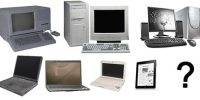Terminal: Generally, a terminal is a combination of keyboard and display screen. Terminals are sometimes divided into three classes based on how much processing power they contain:
- Intelligent terminal: a stand-alone device that contains main and a CPU.
- Smart terminal: contains some processing power, but not as much as an intelligent terminal.
- Dumb terminal: has no processing capability. It relies entirely on the computer’s processor.
Workstation: A workstation is a computer intended for individual use that is faster and more capable than a personal computer. It’s intended for business or professional use (rather than home or recreational use). Workstations and applications designed for them are used by small engineering companies, architects, graphic designers, and any organization, department, or individual that requires a faster microprocessor, a large amount of random access memory (RAM), and special features such as high-speed graphics adapters. Historically, the workstation developed technologically about the same time and for the same audience as the UNIX operating system, which is often used as the workstation operating system. Among the most successful makers of this kind of workstation are Sun Micro systems. Hewlett-Packard, DEC, and IBM.












